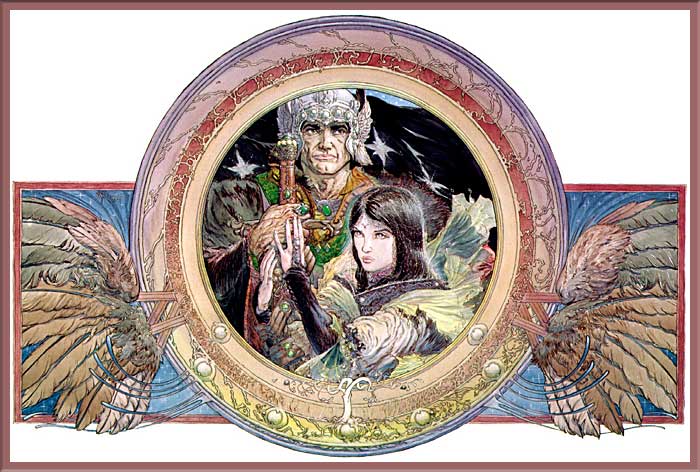Updated 2021 June 21
Upon the very Eve of Midsummer, when the sky was blue as sapphire and white stars opened in the East, but the West was still golden, and the air was cool and fragrant, the riders came down the North-way to the gates of Minas Tirith.
J.R.R. Tolkien, The Return of the King, “The Steward and the King“
Tolkien is describing a time of twilight that may be within an hour of sunset on Midsummer’s Eve in T.A. 3019 (S.R. 1419 1 Lithe). Although it’s not mentioned in this scene of the story, it also happens that the moon on this date, a waxing gibbous moon, would have reached its zenith in the southern sky less than an hour past sunset at this location.
If you are out shortly after sunset this evening (2021 June 20), when the stars are opening in the East “blue as sapphire” but the West is “still golden”, you may have a view of the same kind of sky that greeted Arwen and her escort when they arrived at Minas Tirith on Midsummer’s Eve, including the same kind of waxing gibbous moon at its zenith in the twilight sky!

And Aragorn the King Elessar wedded Arwen Undómiel in the City of the Kings upon the day of Midsummer, and the tale of their long waiting and labours was come to fulfilment.
J.R.R. Tolkien, The Return of the King, “The Steward and the King“

The Tale of Years says the wedding of Aragorn and Arwen was on Mid-year’s Day in T.A. 3019. So Midsummer in the story was synonymous with Mid-year’s Day in the Shire Calendar. It was the middle of 3 holidays that didn’t belong to any month, and fell between that calendar’s months of June and July (between Forelithe and Afterlithe). Since the Shire Calendar originated from the Kings’ Reckoning calendar of Arnor and Gondor, it’s reasonable to assume that the holiday of Mid-year’s Day was inherited from the Kings’ Reckoning holiday of Loëndë, which itself was probably a holiday due to the Erulaitalë religious ceremony observed on Midsummer in Númenor.
I might have thought that Aragorn chose Midsummer for their wedding because it was an ancient holiday for the Kings of Númenor, except the previous passages seem to imply that Aragorn didn’t know exactly when Arwen was going to show up. Not to mention the fact that if King Elessar’s New Reckoning was already established and had taken effect, then its Loëndë was moved to autumn, just a couple of days after Bilbo and Frodo’s birthday, and it would have been T.A. 3019 Cermië 7 by the New Reckoning on this date (although the wedding anniversary gives the peoples of the Reunited Kingdom an excuse to continue celebrating Midsummer into the Fourth Age).
There is no holiday associated with Midsummer in the Reckoning of Rivendell, and this day was simply the 32nd day of “Summer” (that is Lairë or Laer) in the Calendar of Imladris, but I still wonder if it was possible that Arwen or Elrond were responsible for choosing this date of the wedding. Elrond’s twin brother, Elros, was the first King of Númenor, after all.
Due to Shire-reform, Mid-year’s Day in the Shire Calendar also does not fall on any day of the week. Which means 1 Lithe always falls on the last day of the week, a Highday, and 2 Lithe (the day after Mid-year’s Day), always falls on the first day of the week, a Sterday. So just as Shire-reform caused 2 Lithe last year to fall on the first day of the week in the modern Gregorian calendar for this Lunar Read-along, Shire-reform will now cause the days of the week in the Shire Calendar to fall back out of sync with the days of the week in our modern calendar for the rest of this Read-along.